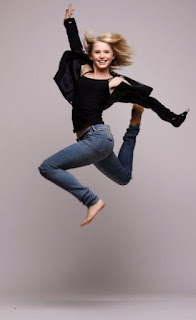Poetry in Motion
Poetry in Motion
| ||
Many "Seinfeld" fans may fondly remember "The Chaperone," the episode in which the characters Elaine Benes and Mr. Justin Pitt meet for the first time. Elaine is interviewing at Doubleday, a publishing house in New York City. Her conversation with the managing editor turns to Jackie O and the ineffable quality of grace. Elaine says, "You know, grace is a tough one. I like to think I have a little grace." Mrs. Landis, the editor, dismisses Elaine's notion out-of-hand, emphatically stating, "You can't have a little grace. You either have grace or you don't." In the next scene, Mr. Pitt, formerly a great friend of Jackie O, tells Elaine, "You don't want too much grace or you won't be able to stand."
Grace is a quality we instinctively recognize in many ballet dancers, medal-winning gymnasts, and professional athletes. The best of these top-level performers not only possess split-second, real-time response mechanisms to almost instantaneously changing physical circumstances, but also have the ability to make it look easy. That remarkable ability is known to us as grace.
Real people, in addition to certain television characters, require a sufficient quantity of grace. We could say that grace enables us to move fluidly, with ease and economy of motion, through three-dimensional space. Very few people can be all-star athletes, a member of the New York City Ballet, or win an award in a high school- or college-level competitive sport, but almost everyone, by applying the principle of grace, can gain flexibility, improve exercise efficiency, and reduce unnecessary effort as we go about our daily business.
Grace is not at all about looking good. In Major League Baseball, when a shortstop dives to his left to snare a hard-hit grounder, spins 360 degrees, and rifles a throw to first base, or in the WNBA, when a guard slashes to the hoop and causally flips in a reverse layup, none of this effort is directed toward good appearances for photographers or television cameras. All their efforts are being put toward solving an immediate problem and their actions are naturally graceful as a result.
When we, too, focus on the task at hand and purposefully execute a perfect (for us) bench press, a 2-mile run, or a 30-minute session in the pool, we are training our muscles, ligaments, and joints (our musculoskeletal system) to perform at optimum capacity.1,2 As we do this work, our bodies naturally develop greater flexibility and fluidity. Our bodies become more effective at performing physical tasks and the many valuable long-term results include grace. Grace is the outward manifestation of our improved physicality, and as such, is a useful indicator of our improved health and well-being.3
Sources
Sources
1. Nakamura PM, et al: Effect on physical fitness of a 10-year physical activity intervention in primary health care settings. J Phys Act Health 12(1): 102-108, 2015
2. Chu CH, et al: Exercise and fitness modulate cognitive function in older adults. Psychol Aging 30(4):842-848, 2015
3. Chung PK, et al: A canonical correlation analysis on the relationship between functional fitness and health-related quality of life in older adults. Arch Gerontol Geriatr 68:44-48, 2016




Comments
Post a Comment